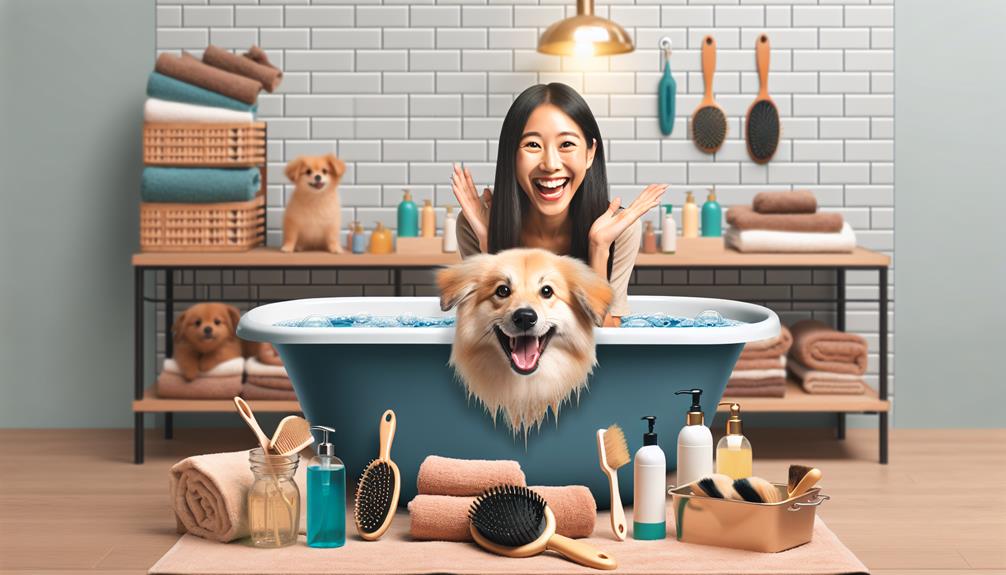When it comes to dog grooming at home, you might be surprised by the many advantages it offers beyond just maintaining your pet’s appearance. From enhancing your bond with your furry companion to ensuring their overall health, the benefits are substantial. By exploring the ins and outs of home grooming, you can discover a world where your dog’s well-being and your relationship with them can flourish. So, are you ready to unlock the secrets of effective home grooming practices that can transform your pet care routine?
Key Takeaways
- Regular grooming monitors health & detects issues early.
- Save trips with essential grooming tools at home.
- Create a safe grooming station for a calming experience.
- Use proper techniques for brushing, bathing, and nail trimming.
- Adjust grooming for different breeds & senior dogs.
Benefits of Home Dog Grooming
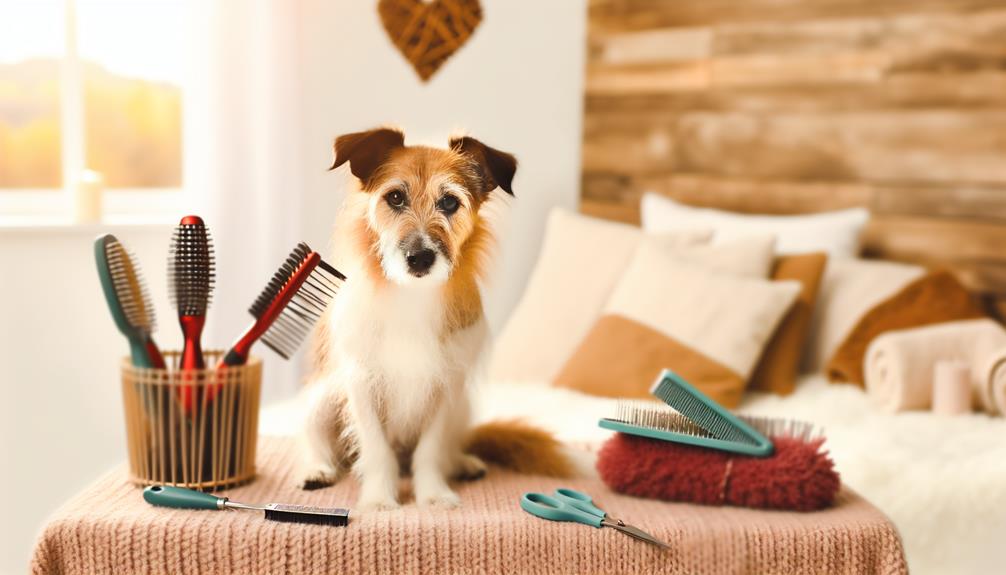
If you groom your dog at home regularly, you can save time and money while strengthening your bond with your furry friend. Regular grooming sessions allow you to monitor your dog’s health by checking for any unusual lumps, bumps, or changes in their skin. Not only does this help in early detection of potential health issues, but it also saves you trips to the groomer or vet for minor concerns.
Grooming your dog at home also provides a great opportunity for bonding. It allows you to spend quality time together, building trust and creating a positive association with grooming. Your dog will learn to feel comfortable and relaxed during grooming sessions, making the process easier and stress-free for both of you.
Additionally, grooming at home can be a calming and therapeutic experience for you as well, promoting relaxation and reducing stress. Overall, the benefits of home dog grooming extend beyond just the physical appearance of your furry companion.
Essential Grooming Supplies
You’ll need to gather essential grooming supplies to keep your furry friend clean and happy. From brushes to nail clippers, having the right tools will make the grooming process easier for both of you.
Additionally, don’t forget to prioritize safety precautions to ensure a stress-free grooming experience.
Tools for Grooming
To properly groom your dog at home, ensure you have the essential grooming supplies ready. The basic tools you’ll need include a dog brush or comb suitable for your pup’s coat type, dog shampoo, towels, and a hairdryer on a low setting.
For trimming your dog’s nails, you should have a quality pair of nail clippers or a nail grinder. Additionally, ear cleaning solution, cotton balls, and a toothbrush with dog-friendly toothpaste are vital for maintaining your dog’s hygiene.
Depending on your dog’s breed and grooming needs, you may also require specific tools like dematting tools, slicker brushes, or grooming scissors. Having these grooming supplies handy will make the grooming process smoother and more enjoyable for both you and your furry friend.
Safety Precautions
Ensure your dog’s safety during grooming by having essential supplies readily available. Start by using a non-slip mat to prevent your dog from slipping in the bathtub. Keep a leash on your dog to maintain control during the grooming process. Have a sturdy grooming table or elevated surface to work on, ensuring stability.
Use blunt-tip scissors and clippers designed for pets to avoid accidental cuts. Keep styptic powder or cornstarch on hand to stop bleeding in case of a cut. Use a gentle shampoo specifically made for dogs to prevent skin irritation.
Lastly, have treats nearby to reward your furry friend for good behavior during the grooming session.
Setting Up Your Grooming Station

Consider arranging your grooming tools in a convenient and organized manner before you begin the grooming process. This will save you time and make the overall experience smoother. Here are four essential tips to help you set up your grooming station effectively:
- Choose a Well-Lit Area: Working in a brightly lit space will help you see what you’re doing clearly and ensure you don’t miss any spots while grooming your dog.
- Use a Non-Slip Mat: Placing a non-slip mat on the floor will provide your dog with stability during the grooming process and prevent any accidents.
- Organize Your Tools: Keep all your grooming tools such as brushes, combs, nail clippers, and towels within arm’s reach to avoid any unnecessary interruptions during the grooming session.
- Prepare Treats: Having treats handy can help keep your dog calm and distracted while you groom them, making the process more enjoyable for both of you.
Brushing and Detangling Fur
When brushing your dog’s fur, make sure to choose the right brush for their coat type.
Start brushing from the tips and work your way up to prevent pulling.
If you encounter any tangles, use a detangling spray to make the process easier for both you and your furry friend.
Choose the Right Brush
Selecting the appropriate brush for your dog’s fur type is crucial for maintaining their coat’s health and appearance. Here are some tips to help you choose the right brush:
- Slicker Brush: Ideal for removing mats and tangles in dogs with medium to long coats.
- Bristle Brush: Great for dogs with short coats and for distributing natural oils for a healthy shine.
- Undercoat Rake: Perfect for double-coated breeds to remove loose fur from the undercoat.
- Comb: Useful for finishing touches and detangling sensitive areas like around the ears and tail.
Start at the Tips
To effectively brush and detangle your dog’s fur, begin at the tips and work your way towards the roots using gentle strokes. Starting at the tips prevents pulling on any tangles or mats, making the process more comfortable for your furry friend.
Hold the fur close to the skin with one hand to avoid any discomfort while brushing. Use a slicker brush or comb designed for your dog’s coat type. Work in small sections, combing through the fur with patience. If you encounter a tangle, hold it at the base and gently work it out with your fingers before using the brush.
Regular brushing not only keeps your dog looking neat but also helps maintain a healthy coat.
Use Detangling Spray
Starting with a detangling spray can help ease the process of brushing and detangling your dog’s fur, ensuring a smoother grooming experience. To make the most of this step, consider the following tips:
- Choose the Right Spray: Opt for a detangling spray specifically designed for dogs to avoid skin irritation.
- Spray Sparingly: Focus on tangled areas and spray lightly to prevent over-saturation.
- Wait a Moment: Allow the spray to work its magic by waiting a few minutes before starting to brush.
- Use a Comb: For stubborn tangles, use a wide-tooth comb after applying the detangling spray to gently work through knots.
These simple steps can make the brushing and detangling process much more manageable for both you and your furry friend.
Bathing Your Dog
When bathing your dog, ensure you have all the necessary supplies within reach before getting started. Gather dog shampoo, towels, a brush, and a non-slip mat for the bathtub or shower.
Start by brushing your dog’s coat to remove any tangles or mats. This will also help prevent clogging the drain with loose fur during the bath. Place your dog in the tub and use lukewarm water to wet its fur thoroughly.
Apply dog shampoo, lather up, and gently massage it into your dog’s coat. Be cautious around the face, ears, and eyes. Rinse your dog’s fur completely to avoid leaving any shampoo residue.
Towel dry your dog by patting its fur gently. For dogs with long coats, you may need to use a hairdryer on a low setting. Remember to praise your dog throughout the process to help them feel calm and comfortable.
Trimming Nails Safely
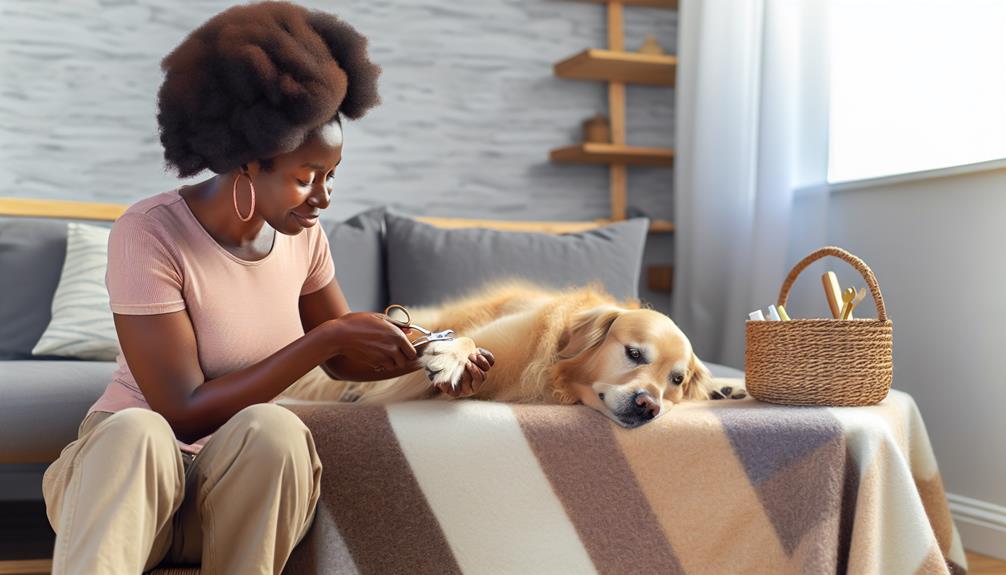
Ensure your dog is calm and relaxed before attempting to trim their nails to ensure a safe and stress-free experience. Trimming your dog’s nails is an essential part of their grooming routine. Follow these tips to trim your dog’s nails safely:
- Pick the Right Tools: Invest in a good quality pair of nail clippers designed specifically for dogs. This will make the task easier and safer.
- Understand the Quick: The quick is a blood vessel inside the nail. Make sure you can identify it before you start trimming. Cutting the quick can cause bleeding and discomfort for your dog.
- Take It Slow: Trim a little at a time. Avoid cutting too close to the quick. Gradually shorten the nails to the desired length over multiple sessions if needed.
- Reward and Reassure: Reward your dog with treats and praise after each nail is trimmed. This positive reinforcement will help them associate nail trimming with something positive.
Cleaning Ears and Eyes
When cleaning your dog’s ears and eyes at home, remember to use gentle techniques to avoid causing discomfort. Proper ear hygiene tips, effective eye care methods, and essential tools for grooming are crucial aspects to consider.
Ear Hygiene Tips
To maintain your dog’s ear hygiene, gently wipe the outer ear with a damp cloth to remove any visible dirt or debris. Regularly checking and cleaning your dog’s ears can help prevent infections and discomfort. Here are some ear hygiene tips to keep your furry friend healthy:
- Use a dog-specific ear cleaning solution: Apply a few drops to the ear and gently massage the base to loosen any buildup.
- Avoid using cotton swabs: They can push debris further into the ear canal and cause damage.
- Inspect for redness, swelling, or foul odor: These could indicate an infection that requires veterinary attention.
- Consult your vet: If you notice unusual symptoms or your dog seems in discomfort, seek professional advice promptly.
Eye Care Methods
For proper eye care methods, start by gently wiping around your dog’s eyes with a damp cloth to remove any debris or discharge. Use a separate damp cloth for each eye to prevent the spread of any potential infections. Be sure to avoid getting any soap or shampoo in your dog’s eyes as this can cause irritation.
If you notice excessive tearing, redness, swelling, or any other concerning symptoms, contact your veterinarian for advice. Regularly checking your dog’s eyes can help catch any issues early on. Remember to reward your dog with a treat and praise after each eye cleaning session to make the experience more positive for them.
Tools for Grooming
Consider including gentle cotton balls or clean gauze pads to effectively clean your dog’s ears and eyes during grooming sessions. When cleaning your dog’s ears and eyes, it’s essential to have the right tools on hand. Here are four items to help you groom your furry friend with ease:
- Ear Cleaning Solution: A specialized solution helps remove wax and debris from your dog’s ears.
- Tear Stain Remover: Helps eliminate tear stains around the eyes, keeping them clean and healthy.
- Fine-Tooth Comb: Ideal for gently combing around the eyes to remove any dirt or debris.
- Eye Wipes: Specially formulated wipes can help clean around the eyes without causing irritation.
Having these tools ready will make the grooming process smoother and more enjoyable for both you and your pup.
Handling Shedding and Mats
Dealing with shedding and mats can be challenging but with the right tools and techniques, you can effectively manage your dog’s grooming at home. To tackle shedding, regular brushing is key. Use a slicker brush for dogs with medium to long hair, and a bristle brush for shorter coats. Brushing not only removes loose fur but also helps distribute natural oils for a healthier coat. For mats, prevention is crucial. Ensure your dog’s coat is tangle-free by brushing regularly, especially in areas prone to matting like behind the ears and under the legs.
If you encounter mats, handle them gently. Use a detangling spray or conditioner to loosen the knots before carefully combing them out. If the mats are too tight, it’s best to seek professional help to avoid causing discomfort or skin irritation to your furry friend. Remember, patience is key when dealing with mats, so take your time and work through them slowly to avoid stressing your dog. By addressing shedding and mats promptly and with the right tools, you can keep your dog’s coat healthy and looking great.
Drying Techniques

When drying your furry friend after a bath, you’ll want to consider towel drying basics, using a blow dryer, or exploring air-drying options.
Each method has its advantages and considerations, so choose the one that suits your dog best for a smooth grooming experience.
Remember to prioritize your pup’s comfort and safety while drying their coat.
Towel Drying Basics
To effectively towel dry your dog after a bath, gently press the towel against their fur in the direction of hair growth. Here are some tips to help you master the art of towel drying your furry friend:
- Patience is key: Take your time and ensure you cover all areas of your dog’s body.
- Use a separate towel for the face: Be gentle around the eyes, ears, and muzzle.
- Check for damp spots: Focus on areas where water may be trapped, like under the belly or between toes.
- Reward your dog: Praise and treats can make the drying process a positive experience for your pup.
Using a Blow Dryer
After towel drying your dog, if you want to speed up the process and ensure thorough drying, using a blow dryer can be a convenient option. Make sure to set the blow dryer on a low heat setting to prevent overheating your pet’s skin.
Keep the dryer moving constantly to avoid focusing heat on one spot for too long. Start drying from the head and work your way down to the tail, following the direction of hair growth. Remember to keep the dryer at a safe distance from your dog’s skin to prevent burns.
Be cautious around sensitive areas like the face, ears, and paws. With proper technique, using a blow dryer can efficiently dry your dog’s coat, leaving it clean and fluffy.
Air Drying Options
Consider utilizing natural air drying techniques to effectively dry your dog’s coat after grooming. Here are some options to help you with the process:
- Towel Drying: Gently pat your dog’s coat with a clean towel to absorb excess water.
- Air Circulation: Position a fan in the room to help speed up the drying process.
- Outdoor Time: If weather permits, let your dog air dry outside in a safe and secure area.
- Brushing: Use a slicker brush while air drying to prevent tangles and promote airflow through the coat.
These methods are gentle on your pup’s skin and coat, ensuring a comfortable drying experience.
Preventing Fleas and Ticks
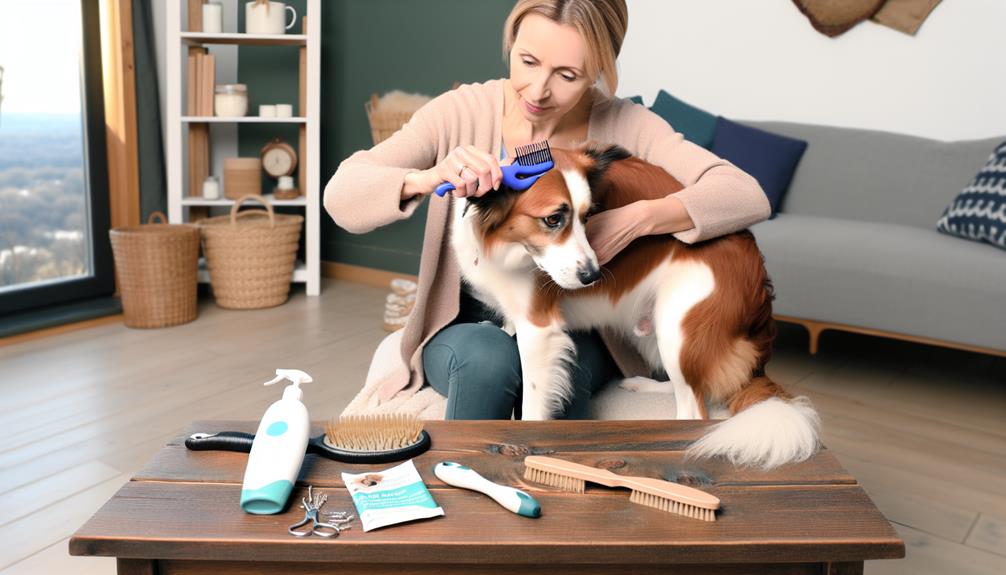
Keep your dog protected from fleas and ticks with these simple preventative measures. Regularly check your furry friend for any signs of these pesky parasites, especially after outdoor adventures. Use a fine-toothed comb to inspect your dog’s fur, paying close attention to areas like behind the ears, around the neck, and between the toes where fleas and ticks often hide.
To prevent infestations, consider using flea and tick prevention products recommended by your veterinarian. These can include topical treatments, oral medications, collars, or sprays. Make sure to follow the instructions carefully and apply the products as directed to ensure their effectiveness.
Maintaining a clean living environment is also crucial in preventing fleas and ticks. Regularly vacuum your home, wash your dog’s bedding, and groom your pet to remove any loose fur where parasites may lay their eggs. Keeping your yard tidy by mowing the grass and removing any debris can also help prevent infestations. By staying vigilant and taking these preventative measures, you can help keep your dog healthy and happy.
Maintaining Dental Hygiene
Regularly brushing your dog’s teeth is essential for maintaining their dental hygiene and overall health. Not only does it prevent bad breath, but it also helps prevent serious dental issues that could lead to infections and pain.
Here are some tips to help you keep your furry friend’s teeth clean and healthy:
- Start Slow: Introduce your dog to tooth brushing gradually to make the experience more pleasant for both of you.
- Use Dog-Friendly Toothpaste: Human toothpaste can be harmful to dogs, so always opt for toothpaste made specifically for canines.
- Be Gentle: Use a soft-bristled toothbrush or a finger brush to avoid causing any discomfort or damaging their gums.
- Stay Consistent: Aim to brush your dog’s teeth at least 2-3 times a week to maintain their oral health effectively.
Safely Handling Aggressive Dogs

To safely handle aggressive dogs, always prioritize your safety and the well-being of the dog by remaining calm and using appropriate techniques for de-escalation. If a dog displays signs of aggression such as growling, baring teeth, or stiff body language, avoid making direct eye contact and don’t run or make sudden movements. Instead, stand still and speak to the dog in a calm, soothing tone. Back away slowly without turning your back on the dog.
When handling an aggressive dog, it’s crucial to never punish or yell at the dog as this may escalate the situation further. Instead, give the dog space and time to calm down. Use positive reinforcement by rewarding calm behavior with treats or praise. If the aggression persists or if you feel unsafe, seek help from a professional dog trainer or behaviorist who can provide guidance on how to manage the situation effectively.
Grooming Different Dog Breeds
Grooming various dog breeds requires understanding their specific coat types and grooming needs to ensure their health and appearance are well-maintained.
Here are some key points to consider when grooming different dog breeds:
- Coat Type: Dogs can have various coat types such as short, long, wiry, curly, or double-coated. Each type requires different grooming techniques to keep the coat healthy and free of mats.
- Breed-specific Needs: Different breeds have specific grooming needs based on their coat texture, length, and shedding patterns. Understanding these requirements will help you groom your dog effectively.
- Regular Brushing: Regular brushing is essential for most breeds to prevent matting, remove loose fur, and distribute natural oils. The frequency of brushing may vary based on the breed.
- Special Considerations: Some breeds may require specialized grooming, such as hand-stripping for terriers or regular trims for poodles. Knowing these breed-specific techniques is crucial for proper grooming.
Tips for Senior Dog Grooming
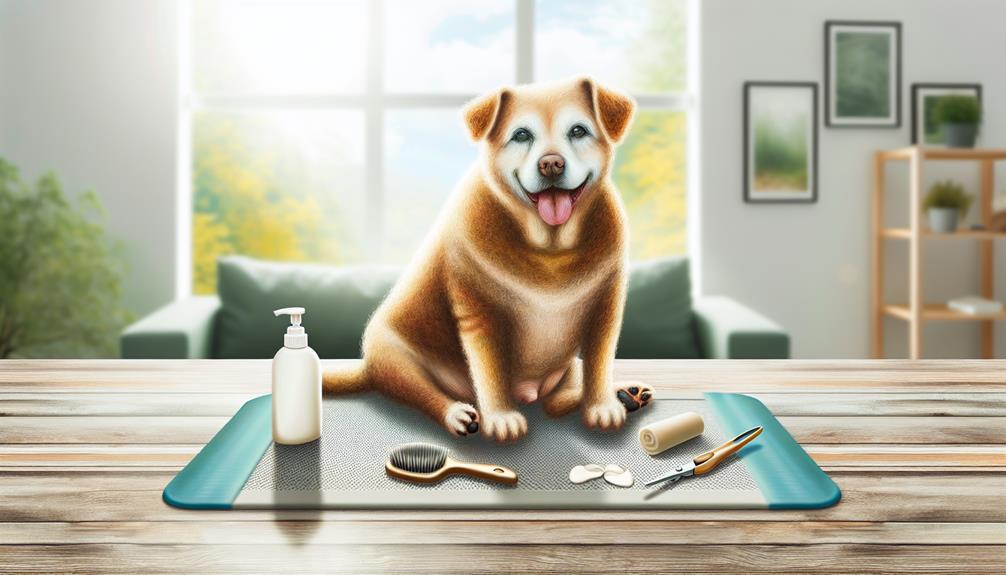
When caring for senior dogs, it’s important to adapt your grooming routine to address their changing needs, including potential mobility issues and sensitive skin. Start by choosing grooming tools that are gentle on their aging skin, such as soft brushes and combs to avoid causing discomfort or irritation.
Regular grooming sessions can also help you monitor your senior dog’s health by checking for lumps, bumps, or changes in their skin condition.
As senior dogs may have joint problems or arthritis, make sure to provide a comfortable and non-slip surface during grooming to prevent accidents or injuries. Trim their nails carefully to avoid overcutting, which can be painful for older dogs with thinner nails.
Additionally, consider using grooming wipes or a damp cloth for spot cleaning instead of giving them frequent baths, which can dry out their skin.
Troubleshooting Common Grooming Issues
If you notice tangled fur on your dog, gently detangle it using a comb or brush designed for their specific coat type. Sometimes grooming your dog at home can lead to common issues that may arise.
Here are some troubleshooting tips to help you address these problems:
- Matted Fur: Use a detangling spray or conditioner to help loosen the mats before carefully combing them out.
- Clipping Mishaps: If you accidentally cut your dog’s fur too short, consult a professional groomer for advice on how to style it as it grows back.
- Nail Cutting Difficulty: If your dog resists nail trimming, try desensitizing them by handling their paws regularly and rewarding them for calm behavior.
- Ear Cleaning Challenges: Use a vet-approved ear cleaner and cotton balls to gently wipe your dog’s ears, being careful not to insert anything into the ear canal.
Frequently Asked Questions
Can I Use Human Grooming Products on My Dog?
You should never use human grooming products on your dog without consulting a vet. Dogs have different skin pH levels and sensitivities. Always choose pet-specific products to avoid potential skin irritation or other health issues.
How Often Should I Groom My Dog at Home?
You should groom your dog regularly based on their breed and coat type. This helps maintain their hygiene, health, and appearance. Consistent grooming also allows you to check for any skin issues or abnormalities early on.
What Should I Do if My Dog Is Afraid of Grooming?
If your dog is afraid of grooming, start by creating a calm environment. Use positive reinforcement, like treats or praise, to associate grooming with rewards. Slowly introduce grooming tools and techniques to help ease their fears.
Are There Specific Grooming Techniques for Different Dog Breeds?
When grooming dogs, specific techniques vary based on breed. Long-haired breeds may require more frequent brushing to prevent matting, while short-haired breeds benefit from regular baths and minimal brushing. Tailor grooming routines to suit your dog’s unique needs.
How Do I Groom a Senior Dog With Mobility Issues?
To groom a senior dog with mobility issues, be gentle and patient. Use a non-slip surface for stability and consider shorter grooming sessions. Brushing, nail trimming, and bathing may require assistance. Prioritize your dog’s comfort and safety.
Conclusion
In conclusion, home dog grooming is a rewarding and beneficial experience for both you and your furry friend. By investing in the necessary supplies and setting up a grooming station, you can ensure your dog’s health and well-being while strengthening your bond.
From brushing and bathing to handling different breeds and senior dogs, regular grooming sessions at home save time and money while promoting a happy and healthy pup. Start grooming your dog at home today for a happier, healthier pet!

